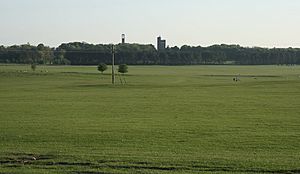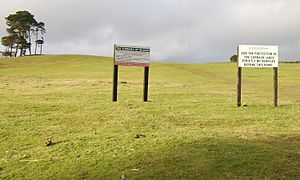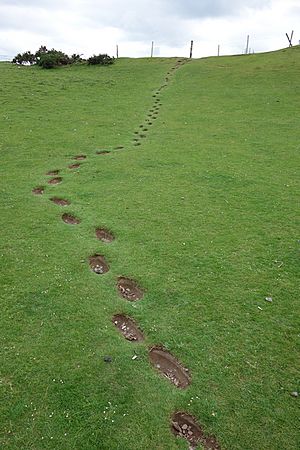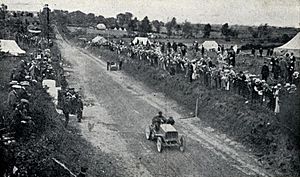Curragh facts for kids
The Curragh (Irish: An Currach) is a big, flat open plain in Newbridge, County Kildare, Ireland. It's about 2,000 hectares (almost 5,000 acres) of shared land. This area is super famous for Irish horse breeding and training. You'll find the Irish National Stud, a special place for horses, right next to Kildare town and the beautiful Japanese Gardens.
The Curragh is also home to Pollardstown Fen, which is the biggest fen (a type of wetland) in Ireland. This place is really cool for scientists who study plants and animals because lots of different birds nest and visit here, and many rare plants grow in the area.
The ground here is very sandy because of ancient glaciers that left sand behind. This sandy soil drains water really well, which is perfect for training racehorses!
Contents
The Curragh's Past
The Curragh has a long and interesting history, full of old stories and legends. Long, long ago, even before Christianity, people used the Curragh as a meeting place.
Legends and Battles
North of the Curragh is the Hill of Allen, a legendary meeting spot for the mythical Fianna, a group of ancient Irish warriors. One famous story says that around 480 AD, St Brigid wanted to build a monastery in Kildare town. She asked the King of Leinster for land. He said she could have as much land as her cloak would cover. When she put her cloak on the ground, it magically spread out to cover the entire Curragh plain!
In 1234, a battle took place at the Curragh. Richard Marshal, 3rd Earl of Pembroke, fought against men loyal to King Henry III of England. Marshal was hurt and later died.
The Curragh was often used as a place for armies to gather. During the 1798 Rebellion, a sad event called the Gibbet Rath massacre happened here. Today, the Curragh Camp, where the Irish Defence Forces train, is located in this area.
There's a natural bowl-shaped area on the Curragh called Donnelly's Hollow. In 1815, the famous Irish boxer Dan Donnelly fought and beat the English champion George Cooper here, with a huge crowd watching!
In 1941, during World War II, the Curragh was even bombed by the German air force, but luckily, the damage was minor.
Protecting the Curragh
The Curragh has been mentioned in legal papers for a very long time, showing how important it is. In 1868, a special law called the Curragh of Kildare Act was passed. This law created a special job for a "Ranger" whose job was to look after the Curragh. Their main goal was to make sure the land was kept safe for horse racing and training.
Later laws also made sure that sheep could still graze on the Curragh, as this was a traditional use of the land. After Ireland became independent in 1921, the Curragh became the property of the Irish government. New laws were made in 1961 to continue protecting the Curragh and its uses.
Military Presence
Since 1856, there has always been a military base at the Curragh. The Curragh Camp is now the main training center for the Irish Defence Forces, Ireland's army.
Sports at the Curragh
Horse Racing
The Curragh Racecourse is Ireland's most important flat horse racing track. Every year, it hosts the five biggest classic races in Ireland:
- The Irish Derby Stakes
- The Irish Oaks
- The Irish 1,000 Guineas
- The Irish 2,000 Guineas
- The St. Leger
Birth of Motor Racing
On July 2, 1903, a very important car race called the Gordon Bennett Cup took place through the Curragh. This was the first international motor race ever held in what was then the United Kingdom of Great Britain and Ireland. Car racing was illegal on public roads in Britain, so Ireland was chosen because its roads were straighter and better for racing.
As a special thank you to Ireland, the British racing team chose to race in a color called Shamrock green. This color later became famous as British racing green. The race was very long, about 328 miles (528 km), and went through several towns. A Belgian driver named Camille Jenatzy won the race in a Mercedes car.
After World War II, both car and motorcycle races were held on the Curragh, attracting huge crowds of up to 30,000 people! Car racing continued until 1954, and motorcycle racing until 1967. Famous drivers like Stirling Moss even raced here.
Education
The Curragh Camp has schools for children living there. There are two primary schools: Curragh Girls' National School and Curragh Boys' National School. There is also one secondary school, the Curragh Post Primary School (PPS), which has been there since 1933. These schools provide education for the children of military families and others in the area.
Images for kids







